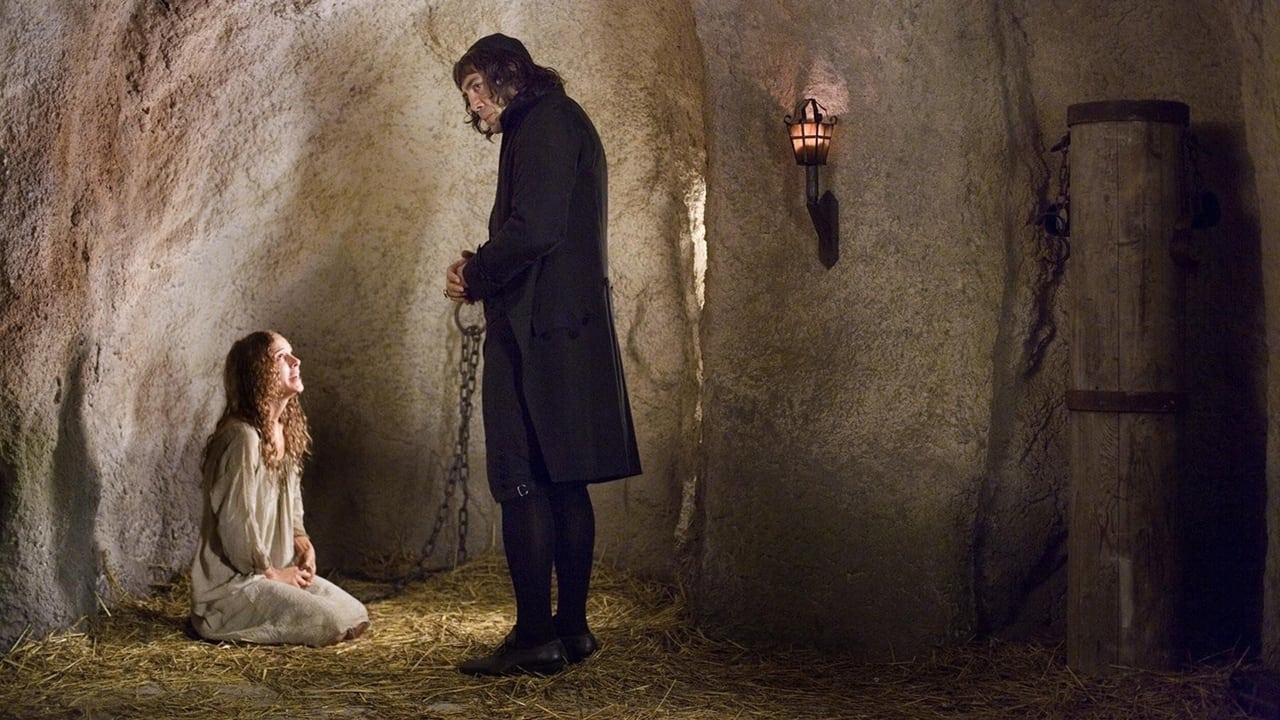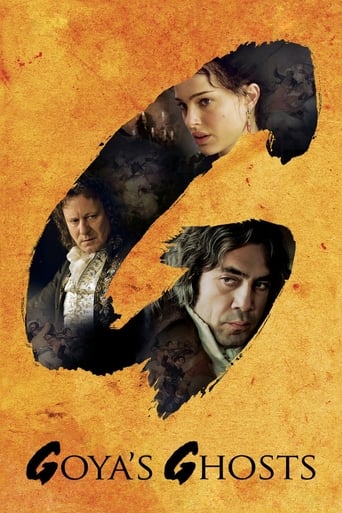

It's 1792 Madrid. The Inquisition is interested in painter Francisco Goya (Stellan Skarsgård)'s provocative art. Luckily for him, brother Lorenzo Casamares (Javier Bardem) is his supportive patron. Inés Bilbatúa (Natalie Portman) is brought into the Inquisition for not eating pork. She is accused of being a Judaiser and put into a stress position called The Question. Her rich merchant father asks Goya to invite Lorenzo for dinner. He in turn puts Lorenzo into The Question to coerce an outlandish confession. He blackmails Lorenzo to help get Inés released.The first hour is terrific. It has dark and tense turns. The characters are great. It builds up a compelling drama. The first problem starts with the family letting Goya leave as they torture Lorenzo. He could easily have gone to the authorities. It's a small logic break but then the story expands in scope and out of shape. This could have been a great movie if it stayed small. Milos Forman goes crazy and then the French invades. The second half is more convoluted and there are too many convenient turns. By way of explaining, I almost half-believed in this as a real Goya story. Granted, I don't know anything about the artist but these characters seem real enough. By the second half, there is no chance that this is anywhere near reality. This is half of a great movie.
... View MoreAt the beginning of the film, I thought it was quite interesting because of course, it seemed to me that it was very different. Why you ask? Because a priest told a young woman's father that he would promise to rescue her from being falsely imprisoned by the Catholic Church. Then when he greeted her at first, he disgraced himself by raping her and got kicked out by the monastery. I didn't get why he broke his promise because it was also concentrating on the painter Goya. OK, since this movie was about him, why did they add Lorenzo and Natalie Portman ' s character? Sure they didn't even exist for starters! Pretty much, Goya is last in the line, he isn't cared much especially having his name mentioned on the movie title! That's very disappointing to think they left Goya out completely!If I was Milos Forman, I would reconsider doing the storyline of the movie again but I would honestly keep the actors because I honestly loved seeing Natalie Portman and Javier Bardem!
... View MoreI would not have appreciated this film so much if I had not been to the Prado (Art Museum) in Madrid. Goya's paintings and drawings of the horrors of war, and the Inquisition, are vividly displayed there. The integration of Goya's art and vision within the film itself is masterful. Add to that excellent costumes, cinematography ,and direction by Milos Foreman; plus incredible pre Oscar performances by Bardem and Portman,and you have a masterpiece worthy of Goya himself. Historically accurate, with a few minor flaws, the film resonates within the soul of the viewer and stands along such great epics of injustice as Schindler's List, and The Pianist.
... View MoreWhen I saw "Goya's Ghosts," I concluded that it was a movie about nothing. To be sure, Milos Forman's direction was expert. The performances were good, especially those of Javier Bardem (as Father Lorenzo) and Stellan Skarsgard (as Francisco Goya). The sets were beautiful. But can one point to a unifying thread in this film? Not really. In the beginning, "Goya's Ghosts" appears to be a movie about the Spanish Inquisition, but half way through it switches gears completely. We are treated to a French invasion (which is eerily similar to the current Iraq War, if you watch carefully the language some of the French officers are using), French atrocities, Goya's reunion with Inez, prostitutes, the British invasion and then the Spanish Inquisition all over again. In the final scene, we witness a wretched mad woman Inez (played by Natalie Portman)carrying a baby and following corpse of Lorenzo stretched out on a cart pulled by a donkey, while ironically cheerful Spanish music is played in the background.So what was the point of this movie? A mystery, but perhaps the answer lies in the opening scene, when we see Lorenzo and other members of the Spanish Inquisition looking over Goya's etchings. "Goya's Ghosts" is not about anything in particular, unless you want to point to very broad themes. Rather, it is a depiction of Spanish life in all its diversity during the late 18th and early 19th century, as seen through the works of Goya. "Goya's Ghosts" are not pretty. They are ugly, absurd, irrational, and downright annoying. The trials and tribulations that these ghosts go through are neverending and no one ever gets closure and certainly no poetic justice. The problems of today will become the problems of tomorrow. But perhaps that's life back then. People live lives without purpose or resolution and then they die. They never find solutions to the big problems of the day. People suffer without finding a way to alleviate the suffering. People are frustrated repeated by others, because the people back then (like those of today) are blind to their own faults or simply too selfish to care about others. Certainly, Goya (in this film) felt that sense of frustration. So in his depiction of Spanish life, Milos Forman does achieve something significant; but it is not the kind of film that people, who are accustomed to stories, are likely to appreciate.
... View More